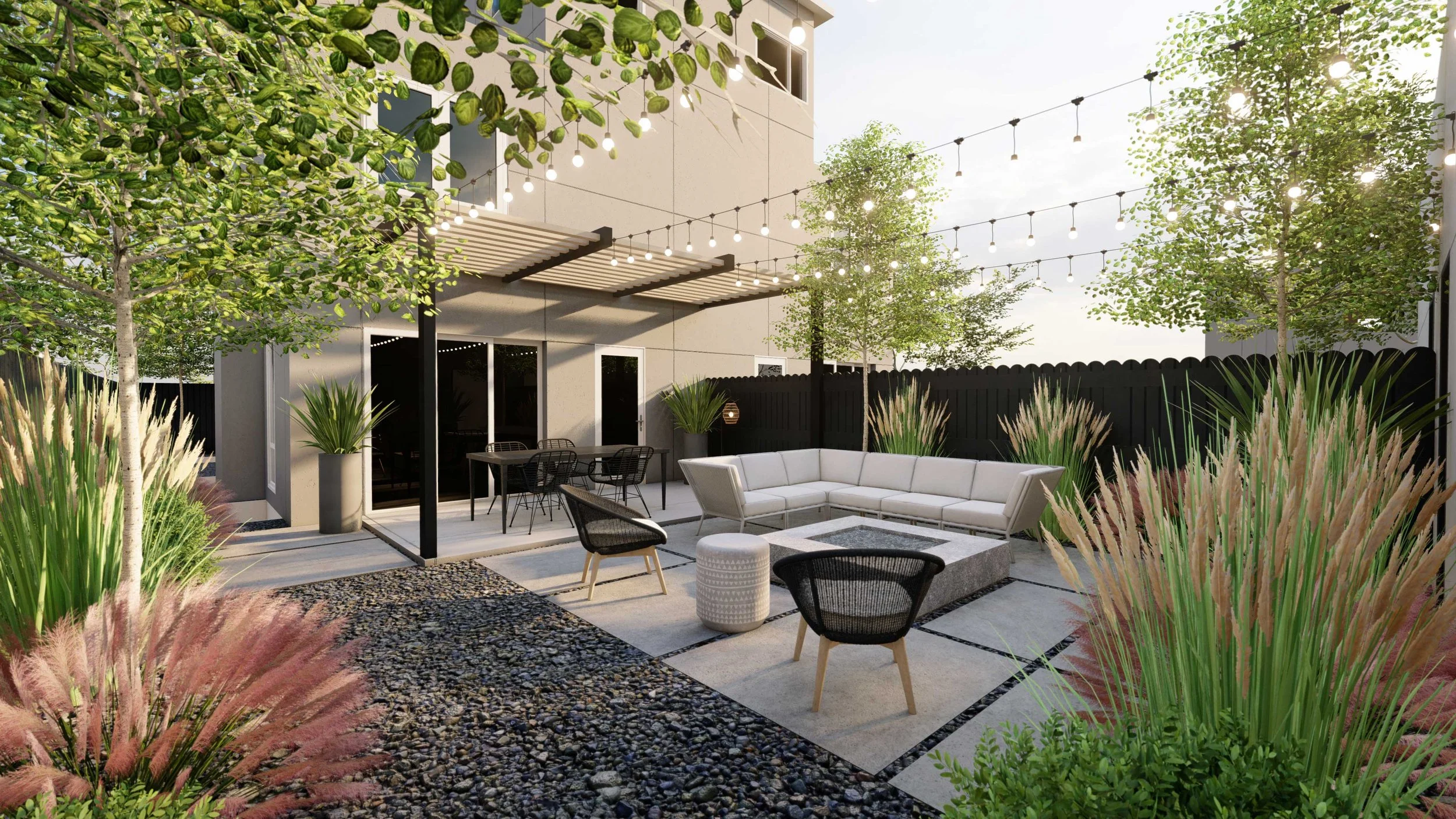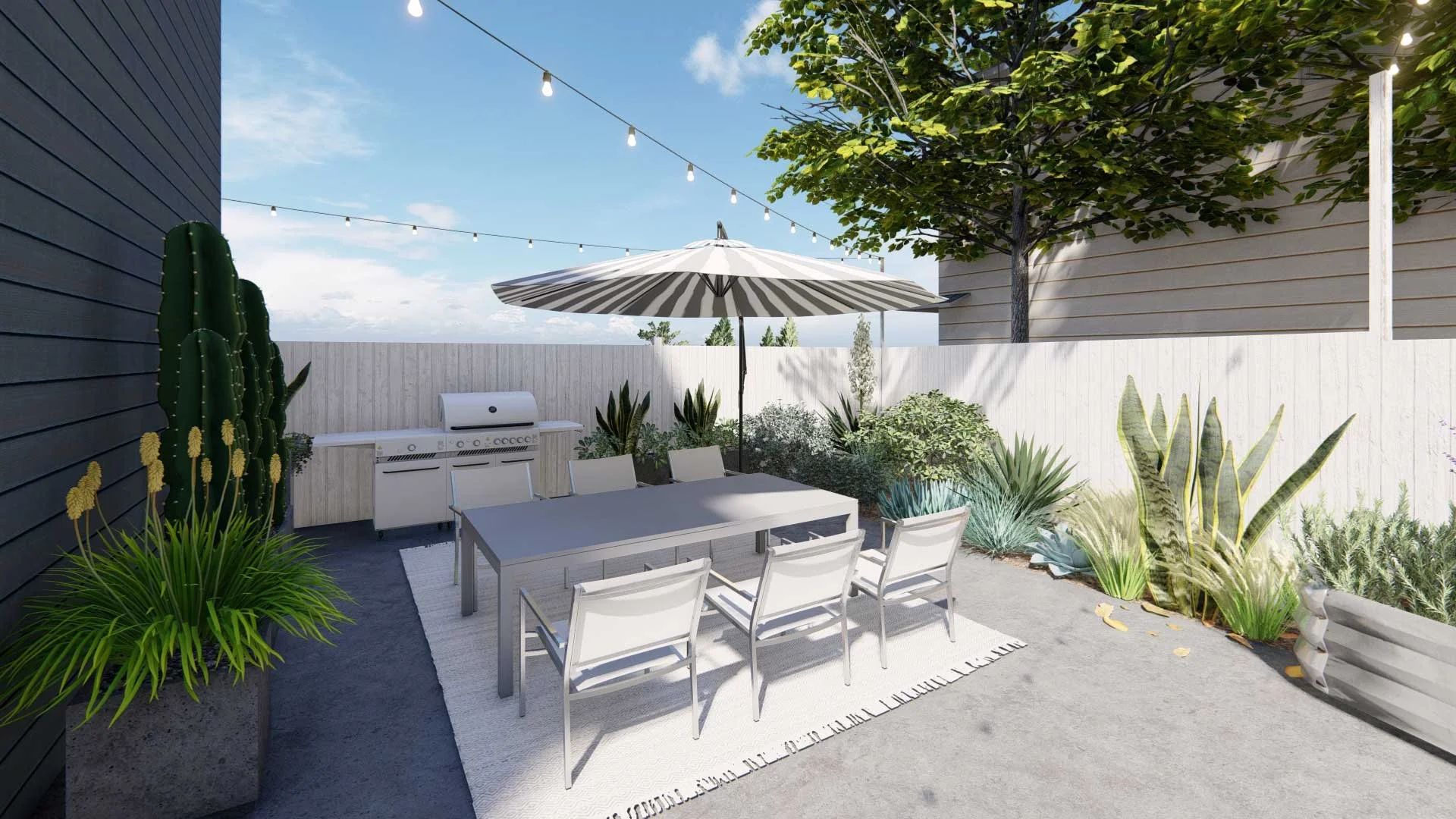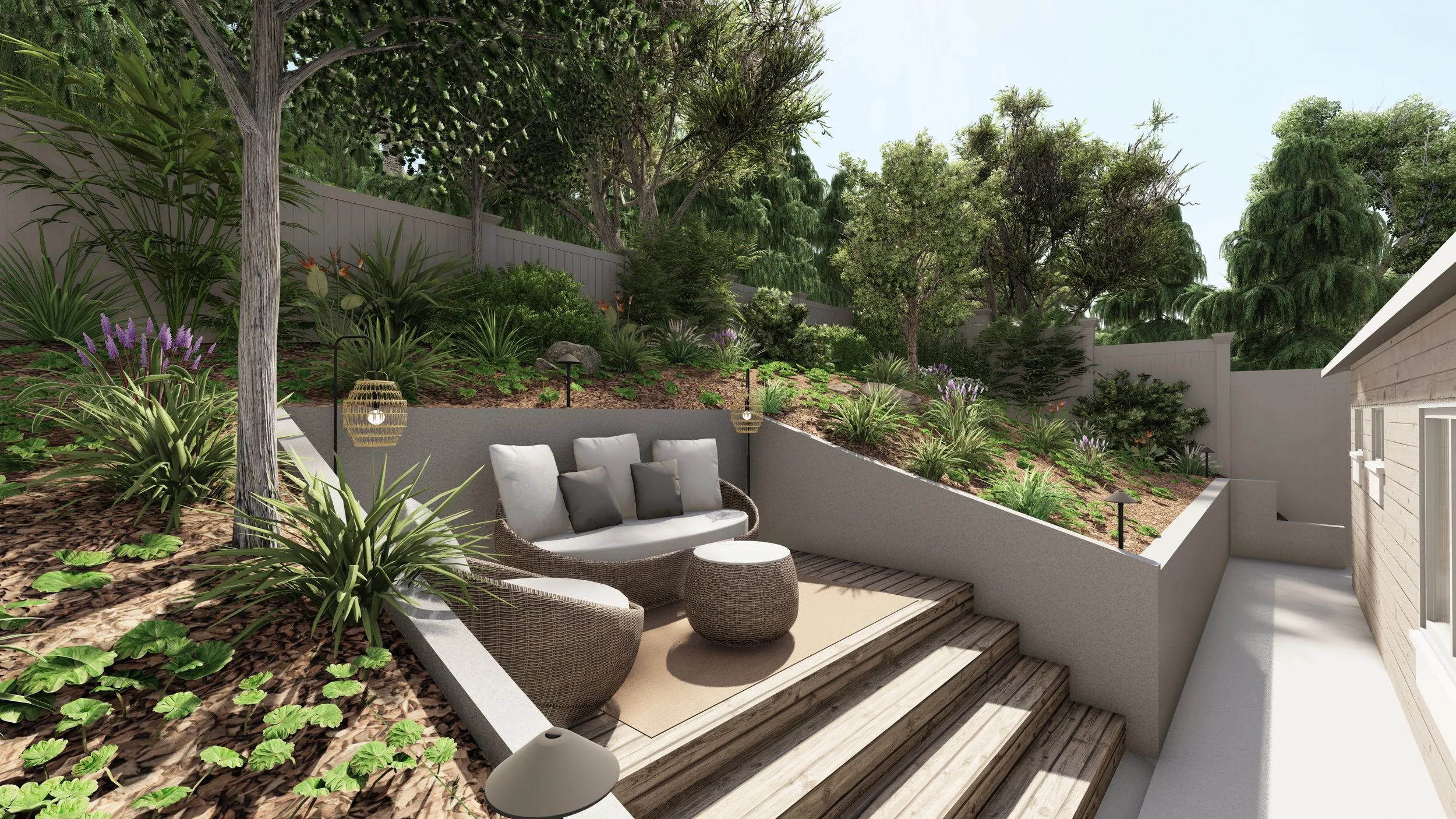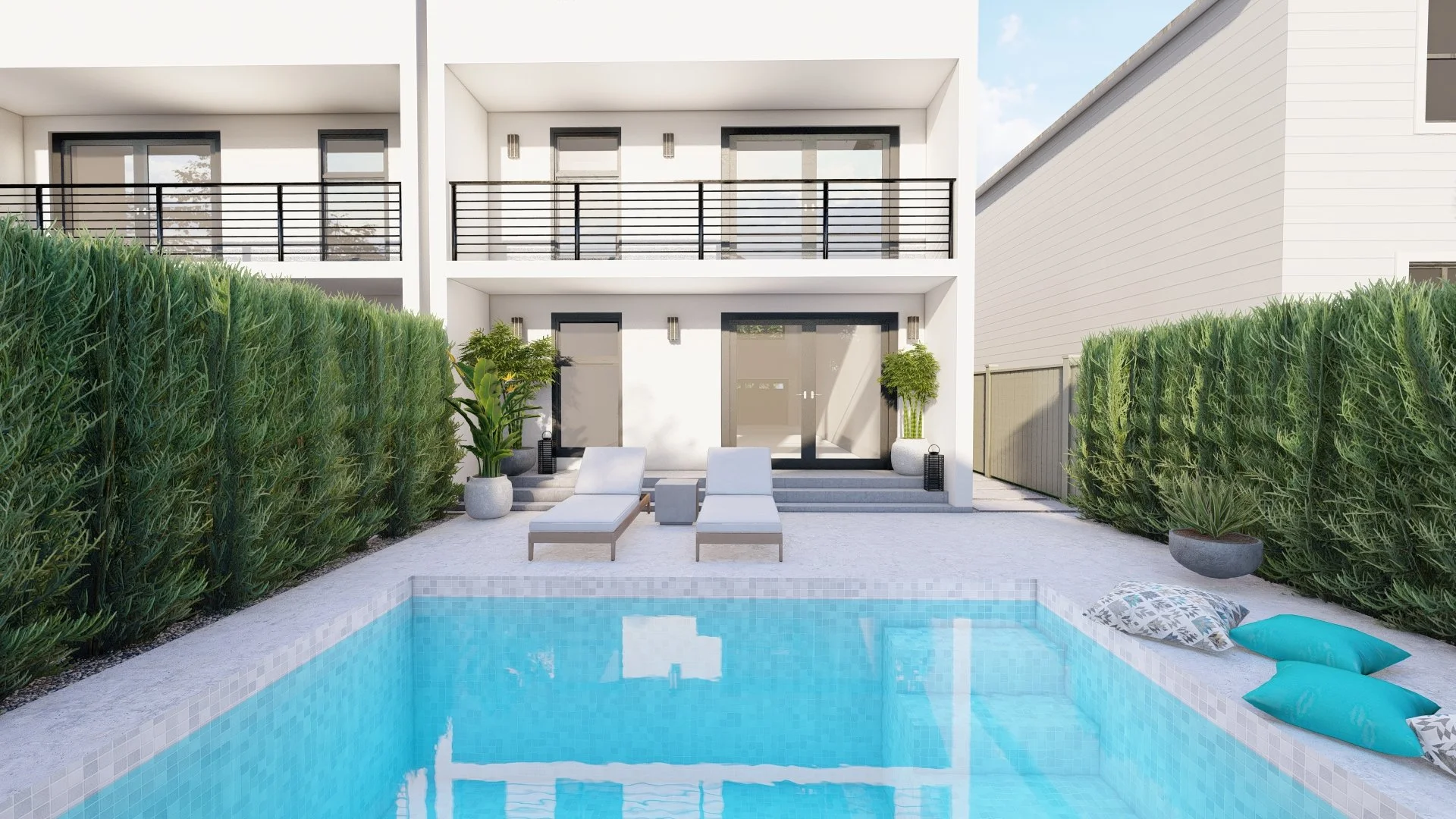Short stories are notoriously difficult to write. Writers must squeeze the full weight of a novel into scant few pages. Small yards present a similar challenge. When space is limited, designs must distill down to the most essential features to achieve a client’s goals.
We love to design small yards—in many ways, they are like a puzzle, and, perhaps counterintuitively, they offer tons of room for creativity. Below, we’ll dig into some overarching strategies and brass tacks tips for getting the most from your small yard.
Design for Seattle condo maximizes new deck space for planters, outdoor dining, and seating area
01 SET GOALS & PRIORITIES
Step one of any landscape design is to identify your goals and prioritize the features you hope to include in your design.
Your design goals should address the functions you hope to achieve—what will you do in your yard?—and the look or feel you’d like to express. Will it be cozy or open? Lush or minimal? Formal or casual? Hot tub or seating area with outdoor furniture?
With small yards, prioritization is extra important. With limited space, it’s best to be open to compromise, letting some lower priority items go to do proper justice to the most important features.
Small back yard makeover in Berkeley, CA with hardscaping and dining area
02 DESIGN FOR FLEXIBILITY & OPENNESS
Every square foot counts in a small yard design. Our advice: design for multiple uses within a single back yard space. Choose movable furniture that can be shifted as needed, and keep edges clear to allow for open circulation and long sight lines.
Avoid dividing up usable spaces with barriers like walls or built-in seating, and remove impediments like thick rows of planting to keep edges clear. Pockets of planting for punctuation are great, but keep the majority of edges between spaces wide open, not walled in.
Maximizing openness and minimizing clutter makes spaces functionally adaptable. They also make them feel bigger, which is a good default goal for most small yards.
A small but greenery-filled New York City back yard garden design filled with New Jersey Tea & Crape Myrtle trees, Climbing Hydrangea, and Wild Ginger.
03 MANIPULATE SPACE
Small yards are often narrow rectangles, not unlike hallways, and can feel like spaces to move through rather than places to linger.
Even if straight lines and boxy spaces are your thing (they’re a hallmark of modern designs), it’s nice to use design to make small yards feel less defined by their rectangular shape. Our advice: manipulate space by playing with edges.
→ Width
Push some edges a bit toward the middle to create narrow moments. These will feel like thresholds to pass through.
Move other edges toward the periphery to create wider spaces. These will feel like areas to spend time in. Combined, you’ll create a sequence of spaces that follow a wide-narrow-wide rhythm.
Don’t get too fussy - it’s generally better to have fewer, larger spaces, but a little spatial diversity adds depth to a design. Two or three areas make sense. Ten do not.
→ Style
For a more traditional feel, make your edges gently curve (but avoid tight, wavy edges). To keep things modern, stick to straight lines and sharp angles.
Maximizing limited space in a Connecticut back yard design with a fire pit, pergola, and perennial flower beds
→ With and against axes
Rectangular yards automatically imply an axis down their middle. Designing along this axis emphasizes the rectangularity of the yard - not necessarily a bad thing, but not particularly novel. If you go this route, employ symmetry, and put a worthy focal point at the axis’s end: a tree, a water feature, a patio with a standout element.
For a more unique and less boxy design, play with diagonal lines. Diagonals break from the default center axis, establishing new, angled edges that make the rectangular shape of a yard melt away. Spaces with diagonal edges tend to feel a little bigger too, especially if they enjoy long sight lines.
Give diagonal edges to your paths, planting areas, or patios, but don’t introduce too many different angles. It’s best to keep your diagonal lines parallel or perpendicular to each other.
→ Nature abhors a straight line
Curving edges are super effective at conveying a natural feel. A careful sequence of planting areas with curved edges is a strong approach for those seeking to design a garden oasis.
Try pin-balling planting areas from one side to the other and back. The alternating curved edges of opposing planting areas will imply a gently meandering path between them. Go for fewer, larger planting areas, not a bunch of small planting islands.
A cozy back yard in Denver, CO with low maintenance and low water grasses
→ Conceal and Reveal
Curves are also excellent at creating mystery. As you round a curve, new views or spaces are revealed.
Use planting—a small canopy tree with a clear understory, an upright grass or shrub at waist height—at the apex of curves to heighten this drama and establish two smaller, cozier spaces on either side.
→ Get Cozy
Small spaces feel cozier than big ones. We’ve been advocating ways to make small yards still feel roomy, but sometimes it’s best to simply embrace the coziness.
Use taller planting, existing vertical structures, or other tall elements along the edges of spaces to ramp up the coziness factor. Yes, this directly contradicts our advice for seeking openness.
If you are going for coziness, take care to keep your living space inviting. Bare walls at the edge of a space are unfriendly. Plants that balance privacy with a little visual permeability are a much nicer boundary to sit beside. Consider how rustling leaves overhead, swaying grasses below, or even a bubbling water feature nearby could lend a comfortable character to more intimate spaces.
For all of the above manipulations of spaces and edges, maintain your focus on openness. When you make those narrow thresholds or create those curving reveals, do so subtly. Remember that the yard is small, and breathing room is essential to comfort, even in cozy spaces.
Outdoor kitchen and dining area surrounded by garden beds, container plants, and herb garden in metal raised beds in Los Angeles, CA back yard
04 REFINE, REFINE, REFINE
Bottom line, you have less room to work with in a small yard. You can’t change this constraint, so it’s best to embrace it. Any design requires a bit of trimming the fat to get to the essential elements, but with small designs this is the designer’s greatest responsibility.
In all aspects of the design, whether picking the number of distinct spaces, choosing furniture types and quantities, or selecting and placing plants—try to only include what is essential. You don’t need to be minimalist. Small yards can have lush planting, decorative flourishes, and plenty of visual detail.
You should, however, get rid of anything that does not play a crucial role. This may mean one seating area instead of three, five plant species instead of ten, or a single path (or none at all) instead of several. Designs almost always improve when non-essential features are removed. Be a little ruthless.
Creating new outdoor seating area in small sloped back yard in California
05 EMPHASIZE CHARACTER
When your design is refined down to the essential elements, each component that remains needs to carry its weight in terms of expressing character.
Not everything must be loud. Background elements are often more important than showpieces, but each ingredient must support a consistent, cohesive aesthetic. Bouncing from one style to the next looks unintentional in larger yards, and looks even less flattering in small yards.
Run each choice through the filter of your overarching aesthetic goals. That means your planting design, materials selections (paving, mulch, wood, gravel or decorative rocks), and elements (furniture, plant containers, decorative items) should all work together as parts of a consistent aesthetic whole.
It’s fine to have a diversity of materials - say a paver, some concrete, and some gravel all sharing paving responsibilities - but make sure the materials you choose express a consistent look and feel.
Furniture and plants offer great opportunities for key character-defining accents. Go for it and embrace a few key accents - a specimen tree, a water feature, a set of boldly colored chairs - just give each focal element its own space. Placing loud accents too close together makes them compete for attention, and detracts from the legibility of your design.
Monochromatic planting design for back yard in Chicago, Illinois
06 PLANT CAREFULLY
Plants are a crucial and versatile part of small yard designs.
→ Layer plant heights
Put low plants along the edges of paths and occupiable spaces. Increase plant height in distinct layers as you move toward the back of planting areas.
If you seek coziness, a canopy tree, waist high planting, or larger container plants can create a more formidable boundary to a space without entirely blocking circulation or views.
→ Use groundcover
Use low groundcover species to fill gaps between scenes of larger ornamental planting. This spreads green over a large surface area to establish a natural feel, yet keeps the total bulk of planting under control, so your planting design doesn’t feel like it’s compromising the openness of your yard.





→ Look up
Trees, tall plants, and even planters mounted to walls all help expand the sense of perceived space by drawing the eye upward.
→ Trees!
You may not have room for many trees, but you can achieve a lot with just one or two well-selected and well-placed trees.
Choose species that suit the scale of the space - namely smaller canopy trees or narrow, upright evergreens. Avoid huge species that will dwarf the yard.
Low canopy trees can imply outdoor rooms, provide privacy from neighbors, and subtly distinguish spaces while maintaining clear views at trunk height.
→ Plant for habitat
Include trees and plants that attract birds and butterflies - natives will be your best bet. Small yards are often in urban areas where nature may be scarcer, so it’s extra nice to be visited by local fauna.
→ Be choosy
With less space to utilize, it's often best to use fewer species in a small yard design.
Your design will look more legible by clustering several plants of a single species together, rather than intermixing individual plants from a larger number of species. Take care to choose species that still provide the same variety in plant height, texture, and foliage color that you’d expect from a larger yard’s design - each species you choose will just have to do a little more lifting to get to this requisite level of diversity.
It doesn’t matter if you seek a geometric or naturalistic design, you’ll achieve greater legibility in limited spaces by limiting your species count.
Southern Wax Myrtle create uniform privacy wall for Miami townhouse back yard
07 KEEP IT FUNCTIONAL
A yard only succeeds if it is easy to use and maintain. Lighting is a must for nighttime use, but don’t go overboard. Keep lights to the edges where they will not cause glare or pose trip hazards. One path light every 15’ is usually plenty—less is more, especially in small yards.
String lights can be fun, but again we advise using them modestly to avoid too many dangling black cables detracting from the daytime appeal of your design. Try to avoid hanging string lights over key views, opting instead to keep them to the periphery of patio spaces.
If storage is required for outdoor cushions, children’s play equipment, or other such items, try to find concealed but convenient areas. Storage benches are a great option, as are small nooks tucked under raised porches or staircases.
Default to low maintenance plants, particularly natives, and provide easy access to planting areas so they can be maintained with little hassle.
We often suggest avoiding lawns in small yards, as they get more difficult to mow and irrigate when corralled into narrow spaces. If you need a play space, artificial turf can be a good alternative.
Small yards can, and should, still pack a big design punch. There’s no need to expect less in terms of satisfaction, though adapting your expectations to the reality of a small space is a key step.
As with any project, healthy dialogue with your designer and your contractor is a key ingredient to achieving a successful outcome. Keep communication clear, consistent, and respectful, and you’ll be well on your way to a fabulous small yard design.
CREATING A SMALL BACK YARD DESIGN TAILORED TO YOUR NEEDS
Yardzen's award-winning online exterior and landscape design service is tailored to homeowners with both large and small yards in all fifty states in the U.S. Our design process begins with understanding your outdoor space, style, garden ideas, and a discussion of your budget and vision to minimize surprises when it comes time to build.
Our top-notch designers then develop a personalized vision for your yard, shared through 3D renderings, 2D plan drawings, and plant and material lists. Your design will capture the look, feel, and function you are hoping for, all while keeping costs within range.
Once your design is complete, we'll help you connect with a local contractor from our Pro Network of vetted professional contractors to install your new design (if you don’t plan on a diy build).
Ready to bring your design ideas to life? Create your design profile or explore our professional exterior, side yard, front yard, and back yard landscaping design packages today!









